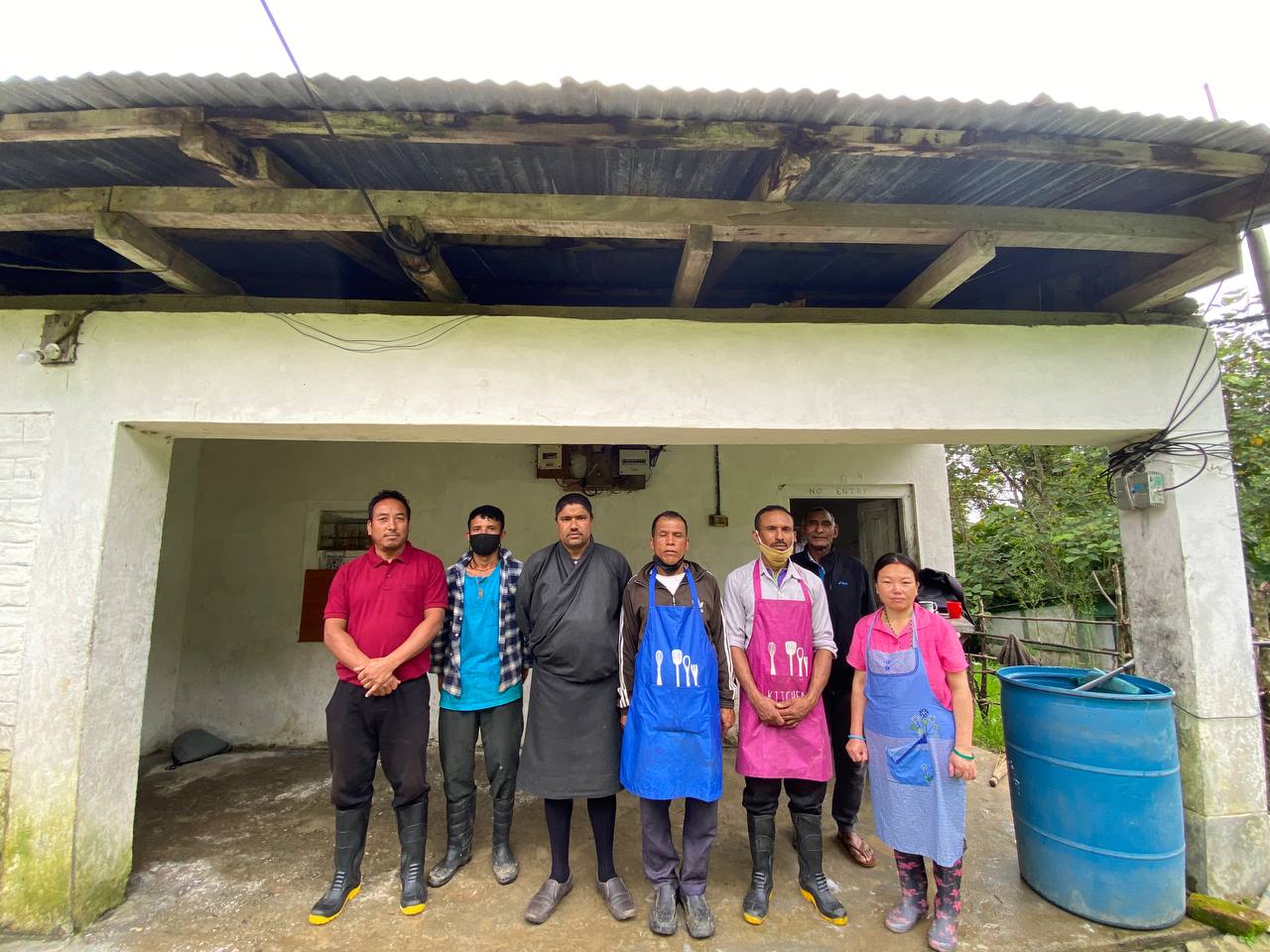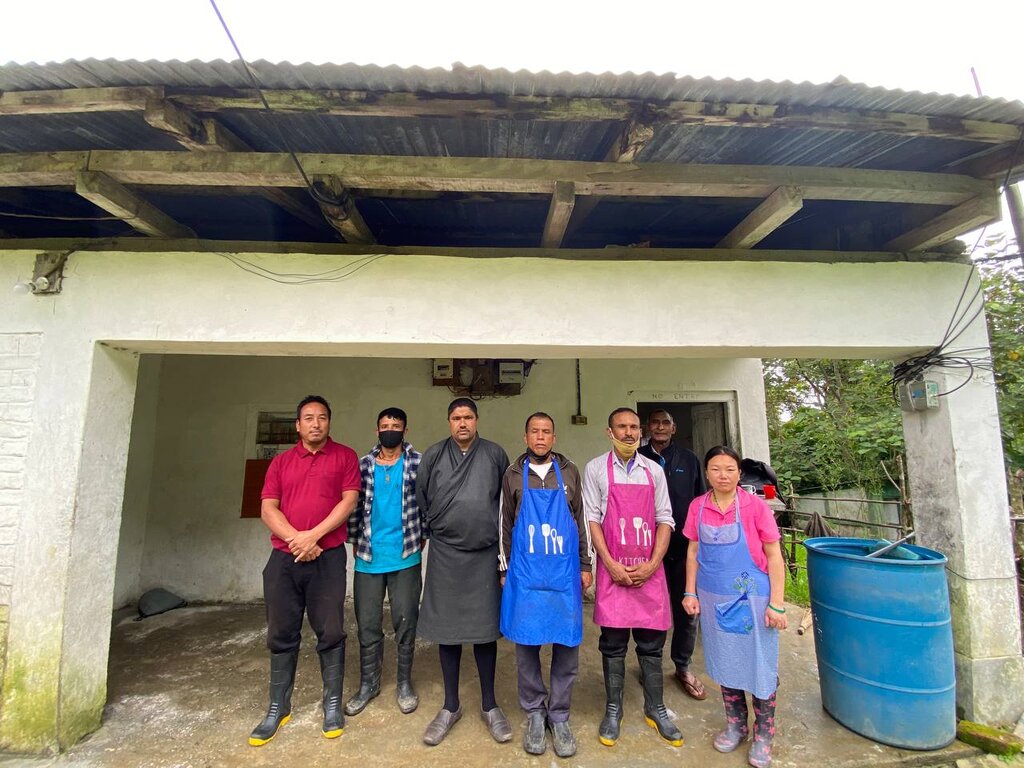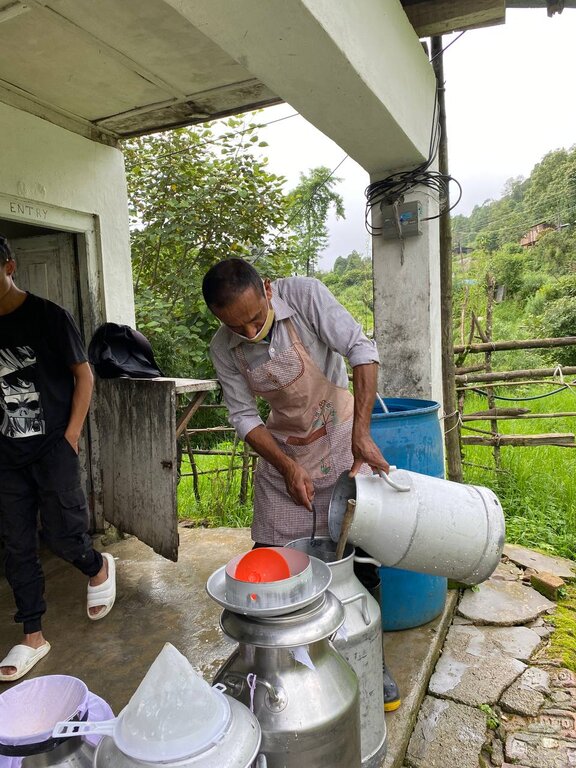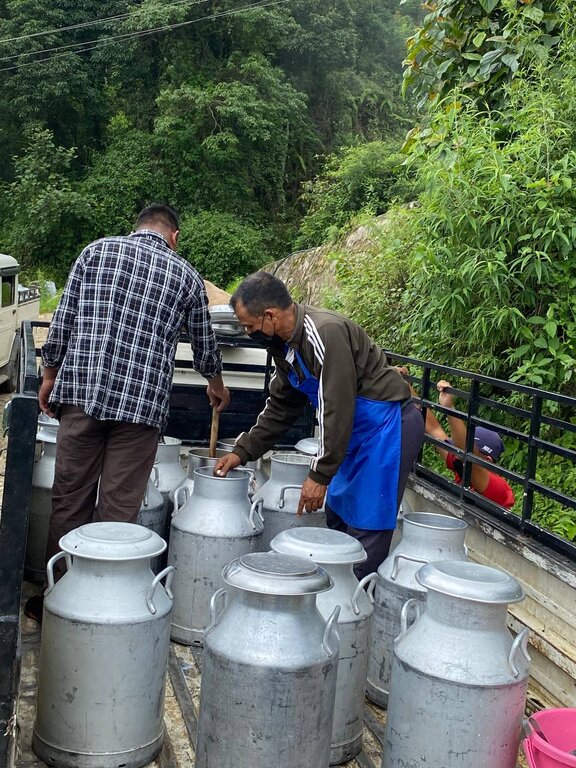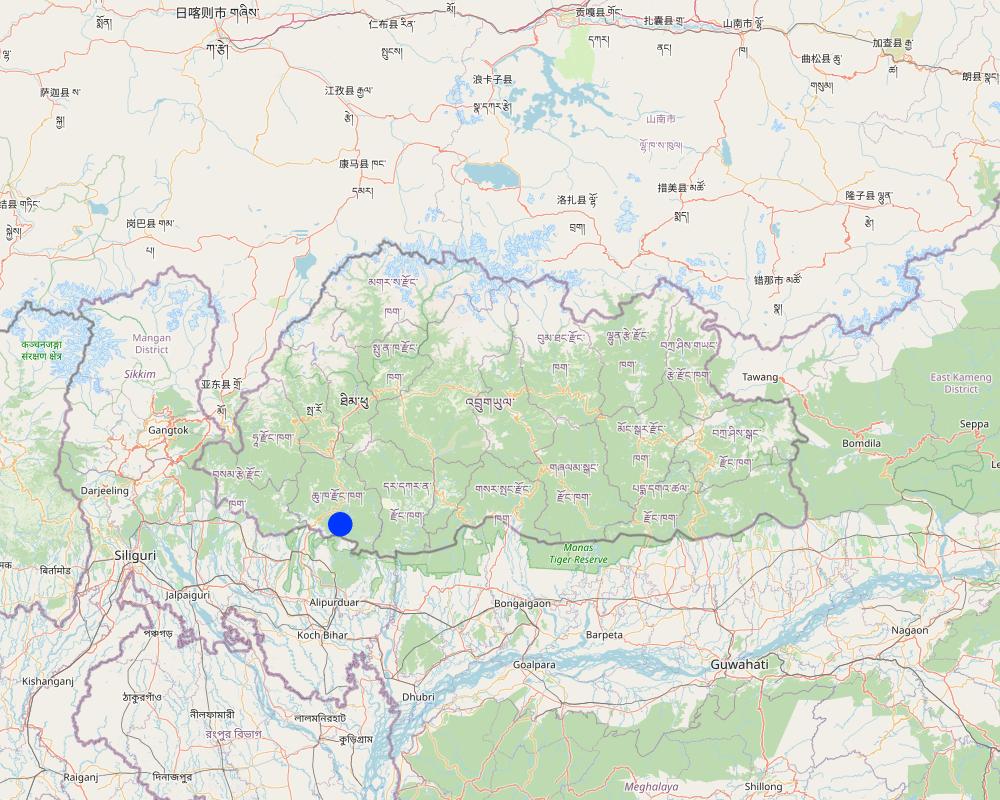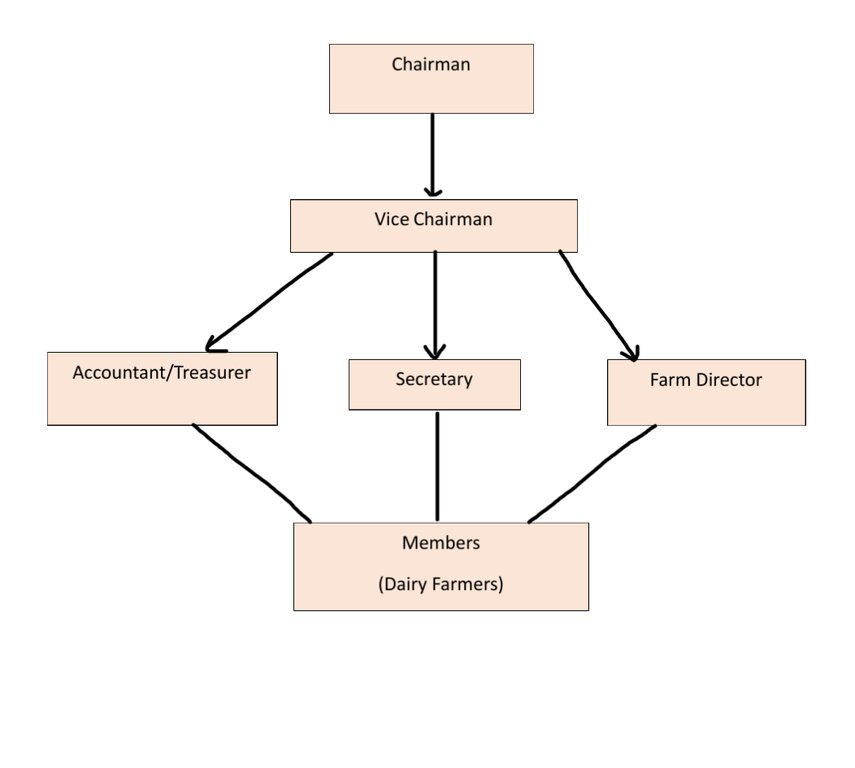Darla Dairy Cooperatives [ບູຕານ]
- ການສ້າງ:
- ປັບປູງ:
- ຜູ້ສັງລວມຂໍ້ມູນ: Karma Wangdi
- ບັນນາທິການ: chenga Tshering
- ຜູ້ທົບທວນຄືນ: William Critchley, Rima Mekdaschi Studer, Joana Eichenberger
Darla Gonor Nyamley Tshogdey (དར་ལ་སྒོ་ནོར་མཉམ་ལས་ཚོགས་སྡེ།)
approaches_6868 - ບູຕານ
ເບິ່ງພາກສ່ວນ
ຂະຫຍາຍທັງໝົດ ຍຸບທັງໝົດ1. ຂໍ້ມູນທົ່ວໄປ
1.2 ລາຍລະອຽດ ການຕິດຕໍ່ ຂອງບຸກຄົນທີ່ຊັບພະຍາກອນ ແລະ ສະຖາບັນ ການມີສ່ວນຮ່ວມ ໃນການປະເມີນຜົນ ແລະ ເອກະສານ ຂອງວິທີທາງ
ບຸກຄົນສຳຄັນ (ຫຼາຍຄົນ)
ຜູ້ນໍາໃຊ້ທີ່ດິນ:
Samal Bal Kumar
17720749
Darla, Chukha Dzongkhag (District)
ບູຕານ
ຜູ້ນໍາໃຊ້ທີ່ດິນ:
Gurung Pancha Maya
16931238
Darla Dairy Cooperative
Darla, Chukha Dzongkhag (District)
ບູຕານ
ຜູ້ນໍາໃຊ້ທີ່ດິນ:
Chettri Datta Singh
16911283
Darla Dairy Cooperative
Darla, Chukha Dzongkhag (District)
ບູຕານ
ຜູ້ນໍາໃຊ້ທີ່ດິນ:
Basnet Chandra Kumar
17810553
Darla Dairy Cooperative
Darla, Chukha Dzongkhag (District)
ບູຕານ
ຜູ້ນໍາໃຊ້ທີ່ດິນ:
Kharki Ram
17480128
Darla Dairy Cooperative
Darla, Chukha Dzongkhag (District)
ບູຕານ
ຊື່ຂອງໂຄງການ ທີ່ອໍານວຍຄວາມສະດວກ ໃນການສ້າງເອກກະສານ ຫຼື ປະເມີນດ້ານແນວທາງ (ຖ້າກ່ຽວຂ້ອງ)
Strengthening national-level institutional and professional capacities of country Parties towards enhanced UNCCD monitoring and reporting – GEF 7 EA Umbrella II (GEF 7 UNCCD Enabling Activities_Umbrella II)ຊື່ຂອງ ສະຖາບັນການຈັດຕັ້ງ ທີ່ອໍານວຍຄວາມສະດວກ ໃນການສ້າງເອກກະສານ ຫຼື ປະເມີນແນວທາງ (ຖ້າກ່ຽວຂ້ອງ)
National Soil Services Centre, Department of Agriculture, Ministry of Agriculture & Livestock (NSSC) - ບູຕານ1.3 ເງື່ອນໄຂ ຂອງການນໍາໃຊ້ເອກກະສານຂໍ້ມູນ ຂອງ WOCAT
ເມື່ອໃດທີ່ໄດ້ສັງລວມຂໍ້ມູນ (ຢູ່ພາກສະໜາມ)?
17/07/2023
ຜູ້ສັງລວມ ແລະ ບັນດາຜູ້ຕອບແບບສອບຖາມ ຍອມຮັບໃນເງື່ອນໄຂ ການນໍາໃຊ້ຂໍ້ມູນເອກະສານ ທີ່ສ້າງຂື້ນ ໂດຍຜ່ານ ອົງການ WOCAT:
ແມ່ນ
2. ພັນລະນາ ແນວທາງການຄຸ້ມຄອງນໍາໃຊ້ດິນແບບຍືນຍົງ
2.1 ການອະທິບາຍ ໂດຍຫຍໍ້ ຂອງວິທີທາງ
The Darla dairy cooperative is an example of where farmers come together to form collective organizations for production, collection, transportation, processing, and marketing of milk and dairy products. These are business models operated as member-owned and member-controlled organizations.
2.2 ການອະທິບາຍ ລາຍລະອຽດ ຂອງວິທີທາງ
ການອະທິບາຍ ລາຍລະອຽດ ຂອງວິທີທາງ:
Livestock in Bhutan are reared for a multitude of purposes, encompassing the production of milk, food, and dung, as well as serving as a means of generating draught power, generating revenue, and accumulating assets. Dairy products, particularly butter and cheese, occupy significant significance within the Bhutanese nutritional framework and have emerged as a noteworthy economic resource for certain households in recent times. Knowing its importance many Bhutanese farmers are forming the cooperative groups. One thing that has been constantly growing over the years in Darla Gewog under Chhukha Dzongkhag is a Farmer’s Cooperative.
Darla dairy cooperatives are business owned and operated by dairy farmers, designed to collectively manage market milk and dairy products (Singh & Gupta, 2015). One of their main features is the collective ownership structure, where farmers become members and actively participate in decision-making processes. By pooling resources, dairy cooperatives enable farmers to access shared facilities, such as milk processing plants and storage, reducing individual cost and enhancing efficiency. Additionally, they offer fair and transparent pricing mechanisms, ensuring farmers receive a competitive price for their milk. Dairy cooperatives also provide valuable technical assistant, training, and access to markets, supporting farmer's growth and sustainability in the dairy industry (USDA, 2015).
The aims and objectives of dairy cooperatives revolve around empowering dairy farmers and promoting their collective welfare. One of the primary objectives is to facilitate shared ownership and democratic decision-making, allowing farmers to collectively manage their dairy operation. Another key aim is to ensure fair and equitable distribution of profits among members, promoting economic sustainability and social development within the dairy community. Dairy cooperatives also strive to provide access to modern technologies empowering farmers with the knowledge and skill needed for sustainable dairy farming practices (FAO, 2019).
The formation of a dairy cooperative typically involves several methods and steps to ensure successful establishment. Firstly, a core group of dairy farmers with common goals come together to initiate the cooperative. They conduct meetings, gauge interest, and identify potential members. Once the core group is established, they create formal bylaws that outline the cooperative's objectives, membership criteria, decision-making processes and profit-sharing mechanisms. To attract more members, awareness campaigns and informational sessions organized by gewog livestock extension agents showcase the benefits of joining the cooperatives. Financial planning and livestock management efforts are also undertaken to raise the necessary capital for initial investments, such as setting up milk processing facilities and infrastructures. There are 101 registered dairy farmers who contribute milk through the cooperative. The dairy cooperative is operated by 6 core members who manage the daily activities.
Dairy cooperatives play a crucial role in the dairy industry by bringing together various stakeholders and facilitating their collaboration. The primary stakeholders involved in dairy cooperative includes dairy farmers who are the core members and owner of the cooperative. They actively participate in decision-making and contribute their milk to the cooperative for processing and marketing. Additionally, consumers are significant stakeholders as they rely on dairy cooperatives to provide them with high quality milk and dairy product. Other stakeholders like the gewog livestock extension agent, the District livestock officer and other officials are involved in a meeting which is conducted twice a year. Marketing opportunities are the main driving forces for producers to produce more of any type of product. Identification of market opportunities and the development of proper marketing strategies for milk and milk products for selected groups of villages would be a useful approach to support dairy cooperatives.
2.3 ຮູບພາບຂອງແນວທາງ
2.5 ປະເທດ / ເຂດ / ສະຖານທີ່ບ່ອນທີ່ແນວທາງໄດ້ຖືກນໍາໃຊ້
ປະເທດ:
ບູຕານ
ພາກພື້ນ / ລັດ / ແຂວງ:
Chukha
ຂໍ້ມູນເພີ່ມເຕີມຂອງສະຖານທີ່:
Darla
Map
×2.6 ວັນທີເລີ່ມຕົ້ນ ແລະ ສິ້ນສຸດ ການຈັດຕັ້ງປະຕີບັດ ວິທີທາງ
ສະແດງປີຂອງການເລີ່ມຕົ້ນ:
2014
ຖ້າຫາກບໍ່ຮູ້ຈັກປີທີ່ແນ່ນອນ, ໃຫ້ປະມານຄາດຄະເນ ເອົາມື້ທີ່ໄດ້ເລີ່ມຈັດຕັ້ງປະຕິບັດ ວິທີທາງ:
ຕໍ່າກວ່າ 10 ປີ ຜ່ານມາ (ມາເຖິງປະຈຸບັນ)
2.7 ປະເພດຂອງແນວທາງ
- ການລິເລີ່ມ ພາຍໃນປະເທດ ທີ່ຜ່ານມາ / ນະວັດຕະກໍາ
2.8 ເປົ້າໝາຍ / ຈຸດປະສົງຫຼັກ ຂອງການຈັດຕັ້ງປະຕິບັດ ວິທີທາງ
The dairy cooperative aims to increase income through marketing of surplus milk, by engaging unemployed youths. Such intervention is expected to address problem srelated to rural urban migration.
2.9 ເງື່ອນໄຂອໍານວຍ ຫຼື ຂັດຂວາງການປະຕິບັດຂອງເຕັກໂນໂລຢີ / ເຕັກໂນໂລຢີການນໍາໃຊ້ຕາມແນວທາງ
ມີຄວາມສາມາດ / ເຂັ້າເຖິງຊັບພະຍາກອນດ້ານການເງິນ ແລະ ການບໍລິການ
- ອໍານວຍ
Priority support is given to the group and cooperatives in terms of investment and financial support by the government.
ການຮ່ວມມື / ການປະສານງານຂອງຜູ້ກ່ຽວຂ້ອງ
- ອໍານວຍ
Dairy cooperative enables farmers' to access and shared facilities, by pooling resources
ຕະຫຼາດ (ໃນການຊື້ວັດຖຸດິບ, ຂາຍຜະລິດຕະພັນ) ແລະ ລາຄາ
- ອໍານວຍ
Increasing demand for milk and dairy products motivate farmers' to raise more dairy cattle and increase production
ວຽກ, ມີກໍາລັງຄົນ
- ອໍານວຍ
Enabled sharing of workload equitabily
3. ການມີສ່ວນຮ່ວມ ແລະ ບົດບາດຂອງພາກສ່ວນທີ່ກ່ຽວຂ້ອງທີ່ໄດ້ມີສ່ວນຮ່ວມ
3.1 ຜູ້ມີສ່ວນຮ່ວມ ໃນວິທີທາງ ແລະ ພາລະບົດບາດ ຂອງເຂົາເຈົ້າ
- ຜູ້ນໍາໃຊ້ດິນໃນທ້ອງຖິ່ນ / ຊຸມຊົນທ້ອງຖິ່ນ
Dairy farmers
Actively participate in decision-making and, produce and supply milk to the cooperative for processing and marketing as specified in the bylaw
- ອໍານາດ ການປົກຄອງທ້ອງຖິ່ນ
Livestock Extension Agent
Provide technical supports (health, feed and fodder, breeding and management) and monitor the progress of cooperative
- ພະນັກງານຂັ້ນສູນກາງ (ຜູ້ວາງແຜນ, ຜູ້ສ້າງນະໂຍບາຍ)
District Livestock Officer
Royal audit authority
Assist in prioritization of issues and planning
Mobilize human and financial resources
Monitor and ensure adequate financial supports
3.2 ການມີສ່ວນຮ່ວມຂອງຜູ້ນໍາໃຊ້ທີ່ດິນໃນທ້ອງຖິ່ນ / ຊຸມຊົນທ້ອງຖິ່ນໃນໄລຍະທີ່ແຕກຕ່າງກັນຂອງແນວທາງ
| ການລວບລວມ ເອົາຜູ້ນໍາໃຊ້ດິນ ໃນທ້ອງຖິ່ນ / ຊຸມຊົນທ້ອງຖິ່ນ | ໃຫ້ລະບຸ ຜູ້ໃດທີ່ມີສ່ວນຮ່ວມ ໃນແຕ່ລະກິດຈະກໍາ? | |
|---|---|---|
| ການເລີ່ມຕົ້ນ / ແຮງຈູງໃຈ | ການຮ່ວມມື | The core dairy farmers with guidance from the Gewog Livestock Extension Agent came up with ideas to establish a dairy cooperative/group. |
| ການວາງແຜນ | ການຮ່ວມມື | Core members along with intellectual people from the village assisted by gewog livestock extension agent planned and proposed. |
| ການປະຕິບັດ | ການຮ່ວມມື | Interested dairy farmers supported by the gewog livestock agent and dzongkhag implemented the activity following the workplan and bylaws agreed upon. |
| ຕິດຕາມກວດກາ / ການປະເມີນຜົນ | ການຊ່ວຍເຫຼືອຈາກພາຍນອກ | The activities of the dairy cooperatives are monitored periodically through field visit, monthly report, Bi-annual general assembly meeting and annual audit. |
3.3 ແຜນວາດ (ຖ້າມີ)
ການອະທິບາຍ:
Presented flow chart of Darla Dairy cooperatives with engagement of all the members
ຜູ້ຂຽນ:
Terms of Reference of Darla Dairy Cooperatives
3.4 ການຕັດສິນໃຈກ່ຽວກັບການຄັດເລືອກເຕັກໂນໂລຢີຂອງການຄຸ້ມຄອງທີ່ດິນແບບຍືນຍົງ / ເຕັກໂນໂລຢີ
ລະບຸ ຄົນທີ່ຕັດສິນໃຈ ກ່ຽວກັບການຄັດເລືອກຂອງ ເຕັກໂນໂລຢີ / ເຕັກໂນໂລຢີ ຈະໄດ້ຮັບການປະຕິບັດ:
- ຜູ້ນໍາໃຊ້ດິນຜູ້ດຽວ (ການລິເລີ່ມດ້ວຍຕົນເອງ)
ອະທິບາຍ:
The idea was conceptualized by the core group members, and accordingly planned and dairy cooperative was established initially. The engagement of other stakeholders came after the establishment.
Specify on what basis decisions were made:
- ປະສົບການສ່ວນບຸກຄົນ ແລະ ຄວາມຄິດເຫັນ (ທີ່ບໍ່ເປັນເອກກະສານ)
4. ການສະໜັບສະໜູນທາງດ້ານວິຊາການ, ການສ້າງຄວາມສາມາດ, ແລະ ການຈັດການຄວາມຮູ້.
4.1 ການສ້າງຄວາມສາມາດ / ການຝຶກອົບຮົມ
ຜູ້ນໍາໃຊ້ທີ່ດິນ ຫຼື ພາກສ່ວນກ່ຽວຂ້ອງອື່ນໆ ໄດ້ຮັບການຝຶກອົບຮົມບໍ່?
ແມ່ນ
ໃຫ້ລະບຸ ຜູ້ໃດທີ່ໄດ້ຮັບການຝຶກອົບຮົມ:
- ຜູ້ນໍາໃຊ້ດິນ
ຮູບແບບຂອງການຝຶກອົບຮົມ:
- ການເຮັດຕົວຈິງ
ໃນຫົວຂໍ້:
Group mobilization, bookkeeping , planning
Hygienic and clean milk production, collection, transportation, and processing.
Breeding and management (AI, Housing, feeding system)
ຄວາມຄິດເຫັນ:
The specialized training was provided by subject matter specialist, and on basic topic by the respective Extension Agent
4.2 ການບໍລິການໃຫ້ຄໍາປຶກສາ
ເຮັດຜູ້ໃຊ້ທີ່ດິນມີການເຂົ້າເຖິງການບໍລິການໃຫ້ຄໍາປຶກສາ?
ແມ່ນ
ລະບຸວ່າການສະໜອງ ການບໍລິການ ໃຫ້ຄໍາປຶກສາ:
- ໃນພື້ນທີ່ຂອງຜູ້ນໍາໃຊ້ດິນ
ອະທິບາຍ / ຄວາມຄິດເຫັນ:
Officials from NCOA Yusipang monitored their work, and livestock officials organized awareness program on the management, care, prevention and control of common cattle diseases
4.3 ສະຖາບັນການສ້າງຄວາມເຂັ້ມແຂງ (ການພັດທະນາອົງການຈັດຕັ້ງ)
ສະຖາບັນ ໄດ້ຮັບການສ້າງຕັ້ງຂື້ນ ຫຼື ໄດ້ຮັບການສ້າງຄວາມເຂັ້ມແຂງ ໂດຍການຈັດຕັ້ງປະຕິບັດ ວິທີທາງບໍ່?
- ມີ, ພໍສົມຄວນ
ລະບຸ ທາງສະຖາບັນ ໄດ້ສ້າງຄວາມເຂັ້ມແຂງ ໃນລະດັບໃດ (ຫຼາຍ):
- ທ້ອງຖິ່ນ
ອະທິບາຍ ສະຖາບັນການຈັດຕັ້ງ, ພາລະບົດບາດ ແລະ ໜ້າທີ່ຮັບຜິດຊອບ, ສະມາຊິກ ແລະ ອື່ນໆ.
The number of dairy cooperative members have increased by 15 households.
ລະບຸ ປະເພດ ຂອງສະໜັບສະໜູນ:
- ອຸປະກອນ
ໃຫ້ລາຍລະອຽດເພີ່ມເຕີມ:
All members of the cooperative were supplied with milk cans to collect, store and transport milk
4.4 ຕິດຕາມກວດກາ ແລະ ປະເມີນຜົນ
ການຈັດຕັ້ງປະຕິບັດ ວິທີທາງ ໄດ້ມີການປະເມີນຜົນ ແລະ ຕິດຕາມບໍ?
ແມ່ນ
ຄວາມຄິດເຫັນ:
Physical on site monitoring and evaluating the quality, standard, cleanliness of the work and products
ຖ້າແມ່ນ, ເອກກະສານສະບັບນີ້ ແມ່ນໄດ້ນໍາໃຊ້ເຂົ້າໃນການຕິດຕາມ ແລະ ປະເມີນຜົນບໍ່?
ບໍ່ແມ່ນ
4.5 ການຄົ້ນຄວ້າ
ນີ້້ແມ່ນສ່ວນໜຶ່ງ ການຄົ້ນຄວ້າ ຂອງວິທີທາງບໍ່?
ບໍ່ແມ່ນ
5. ການສະໜັບສະໜູນທາງດ້ານການເງິນ ແລະ ອຸປະກອນຈາກພາຍນອກ
5.1 ງົບປະມານປະຈໍາປີ ສໍາລັບວິທີທາງ ຂອງການຄຸ້ມຄອງ ທີ່ດິນແບບຍືນຍົງ
ຖ້າຫາກບໍ່ຮູ້ຈັດງົບປະມານທີ່ແນ່ນອນ ແມ່ນໃຫ້ປະມານເອົາ:
- 10,000-100,000
ຄໍາເຫັນ (ຕົວຢ່າງ: ແຫຼ່ງຂໍ້ມູນຫຼັກ ຂອງການສະໜອງທຶນ / ຜູ້ໃຫ້ທຶນທີ່ສໍາຄັນ):
The approach was implemented with the seed money collected from the members.
5.2 ການສະໜັບສະໜູນ ທາງດ້ານການເງິນ / ອຸປະກອນ ສະໜອງໃຫ້ແກ່ຜູ້ນໍາທີ່ດິນ
ຜູ້ນໍາໃຊ້ດິນ ໄດ້ຮັບການສະໜັບສະໜູນ ທາງດ້ານ ການເງິນ / ອຸປະກອນ ໃນການຈັດຕັ້ງປະຕິບັດ ເຕັກໂນໂລຢີບໍ?
ແມ່ນ
ຖ້າແມ່ນ, ໃຫ້ລະບຸປະເພດ (ຫຼາຍ) ຂອງການສະໜັບສະໜູນ, ເງື່ອນໄຂ ແລະ ຜູູ້ສະໜອງ (ຫຼາຍ):
They were provided with the milk processing equipment
5.3 ເງິນສົມທົບສໍາລັບການນໍາໃຊ້ສະເພາະປັດໃຈຂາເຂົ້າໃນການຜະລີດກະສິກໍາ (ລວມທັງແຮງງານ)
- ກະສິກໍາ
| ໃຫ້ລະບຸໄດ້ຮັບການສະໜັບສະໜູນປັດໃຈຂາເຂົ້າຫຍັງແດ່ | ທີ່ຂອບເຂດ | ລະບຸ ການອຸດໜູນ |
|---|---|---|
| Machines | ງົບປະມານເຕັມສ່ວນ | -Chunning machine -Office furnitures - cream separator -analyzer -yogurt incubator -deep freezer and fridge |
ຄວາມຄິດເຫັນ:
The government fully funded construction of milk processing, and is being operated by the cooperative free of cost.
5.4 ສິນເຊື່ອ
ໄດ້ປ່ອຍສິນເຊື່ອ ສະໜອງໃຫ້ພາຍໃຕ້ ວິທີການສໍາລັບກິດຈະກໍາ ການຄຸ້ມຄອງ ທີ່ດິນແບບຍືນນຍົງບໍ່?
ບໍ່ແມ່ນ
5.5 ສິ່ງຈູງໃຈ ຫຼື ເຄື່ອງມືອື່ນໆ
ການສົ່ງເສີມ ຈັດຕັ້ງປະຕິບັດ ເຕັກໂນໂລຢີ ໃນການຄຸ້ມຄອງ ດິນແບບຍືນຍົງ ໄດ້ສະໜອງສິ່ງກະຕຸກຊຸກຍູ້ບໍ່?
ບໍ່ແມ່ນ
6. ວິເຄາະຜົນກະທົບ ແລະ ສັງລວມບັນຫາ
6.1 ຜົນກະທົບຂອງແນວທາງ
ວິທີທາງ ຊ່ວຍຊຸກຍູ້ ຜູ້ນຳໃຊ້ທີ່ດິນທ້ອງຖີ່ນ, ໃນການປັບປຸງ ການມີສ່ວນຮ່ວມ ຂອງຜູ້ທີ່ກ່ຽວຂ້ອງ ບໍ່?
- ບໍ່
- ມີ, ໜ້ອຍໜຶ່ງ
- ມີ, ພໍສົມຄວນ
- ມີ, ຫຼາຍ
They got more recognition and support
ການນໍາໃຊ້ ວິທີທາງ ດັ່ງກ່າວນີ້ ສາມາດເປັນຫຼັກຖານ ທີ່ສະໜັບສະໜູນ ໃຫ້ການຕັດສິນໃຈໄດ້ບໍ່?
- ບໍ່
- ມີ, ໜ້ອຍໜຶ່ງ
- ມີ, ພໍສົມຄວນ
- ມີ, ຫຼາຍ
future plans are drawn based on the needs, issues and challages faced during the operation of dairy cooperative
ການນໍາໃຊ້ ວິທີທາງ ສາມາດສ້າງຄວາມເຂັ້ມແຂງ ໃຫ້ສະຖາບັນການຈັດຕັ້ງ, ການຮ່ວມມື ລະຫວ່າງພາກສ່ວນທີ່ກ່ຽວຂ້ອງບໍ່?
- ບໍ່
- ມີ, ໜ້ອຍໜຶ່ງ
- ມີ, ພໍສົມຄວນ
- ມີ, ຫຼາຍ
Physical and financial support received have enhanced, improved social cohesion
ການຈັດຕັ້ງປະຕິບັດ ວິທີທາງ ສາມາດປັບປຸງ ຄວາມສະເໜີພາບ ຂອງບົດບາດ ຍິງຊາຍ ແລະ ສ້າງຄວາມເຂັ້ມແຂງໃຫ້ຜູ້ຍິງໄດ້ບໍ່?
- ບໍ່
- ມີ, ໜ້ອຍໜຶ່ງ
- ມີ, ພໍສົມຄວນ
- ມີ, ຫຼາຍ
Every men and women is given equal right.
ການນໍາໃຊ້ ວິທີທາງ ໄດ້ປັບປຸງ ການຄໍ້າປະກັນສະບຽງອາຫານ ຫຼື ປັບປຸງໂຄສະນາການໄດ້ບໍ່?
- ບໍ່
- ມີ, ໜ້ອຍໜຶ່ງ
- ມີ, ພໍສົມຄວນ
- ມີ, ຫຼາຍ
Increased milk and dairy products and excess dairy products are processed and supplied to schools, hospitals and other markets.
ການຈັດຕັ້ງປະຕິບັດ ວິທີທາງ ສາມາດປັບປຸງ ການເຂົ້າເຖິງຕະຫຼາດໄດ້ບໍ?
- ບໍ່
- ມີ, ໜ້ອຍໜຶ່ງ
- ມີ, ພໍສົມຄວນ
- ມີ, ຫຼາຍ
Formalized group marketing, and the quality of milk products have improved
ການນໍາໃຊ້ ວິທີທາງ ໄດ້ປັບປຸງ ການຈ້າງງານ, ໂອກາດ ໃນການສ້າງລາຍຮັບບໍ່?
- ບໍ່
- ມີ, ໜ້ອຍໜຶ່ງ
- ມີ, ພໍສົມຄວນ
- ມີ, ຫຼາຍ
Some school drop-outs and laid-off youths are employed in collecting and transportation of milk.
6.2 ແຮງຈູງໃຈຫຼັກຂອງຜູ້ນໍາໃຊ້ທີ່ດິນໃນການປະຕິບັດການຄຸ້ມຄອງທີ່ດິນແບບຍືນຍົງ
- ກໍາໄລເພີ່ມຂຶ້ນ (ຄວາມສາມາດ), ການປັບປຸງຄ່າໃຊ້ຈ່າຍ, ຜົນປະໂຫຍດ, ອັດຕາສ່ວນ
Member earn an average gross monthly income between Nu. 30000-40000
- ການຊໍາລະເງິນ / ເງິນອຸດໜູນ
Government provide subsidies (materials support) for the construction of improved dairy shed
- ລວມເຂົ້ານໍາກັນກັບການເຄື່ອນໄຫວ / ໂຄງການ / ກຸ່ມ / ເຄືອຂ່າຍ
Their products are marketed within the gewog, and excess products are marketed to other districts
6.3 ຄວາມຍືນຍົງຂອງກິດຈະກໍາວິທີທາງ
ຜູ້ນໍາໃຊ້ ທີ່ດິນ ສາມາດສືບຕໍ່ ການຈັດຕັ້ງປະຕິບັດ ຜ່ານວິທີທາງໄດ້ບໍ່ (ໂດຍປາດສະຈາກ ການຊ່ວຍເຫຼືອ ຈາກພາກສ່ວນພາຍນອກ)?
- ແມ່ນ
ຖ້າ ໄດ້, ອະທິບາຍເຫດຜົນ:
The initial investment has been recovered, and current income meets the operation cost.
6.4 ຈຸດແຂງ / ຂໍ້ດີ ຂອງວິທີທາງ
| ຈຸດແຂງ / ຂໍ້ດີ / ໂອກາດໃນການນໍາໃຊ້ທີ່ດິນ |
|---|
| Source of cash income |
| Increased cooperation and network |
| improve household livelihood |
| ຈຸດແຂງ / ຈຸດດີ / ໂອກາດ ຈາກທັດສະນະຂອງຜູ້ປ້ອນຂໍ້ມູນ ຫຼື ບຸກຄົນສຳຄັນ |
|---|
| Creates employment opportunities to the school drop-outs and rural youths |
| Contributes to food security and better nutrition |
6.5 ຈຸດອ່ອນ / ຂໍ້ເສຍຂອງແນວທາງ ແລະ ວິທີການແກ້ໄຂໃຫ້ເຂົາເຈົ້າ
| ຈຸດອ່ອນ / ຂໍ້ເສຍ / ຄວາມສ່ຽງໃນມູມມອງຂອງຜູ້ນໍາໃຊ້ທີ່ດິນ | ມີວິທີການແກ້ໄຂຄືແນວໃດ? |
|---|---|
| Scattered settlement and production | Increase the number of transportation vehicles, improve road connectivity |
| Short shelf life of milk | Try marketing in nearby places if possible, install cold chain facilities |
| Delay in payment | Create a terms of agreement with the retailers to ensure payment on time |
| ຈຸດອ່ອນ ຫຼື ຂໍ້ເສຍ ຫຼື ຄວາມສ່ຽງ ໃນມຸມມອງຂອງ ຜູ້ສັງລວມຂໍ້ມູນ ຫຼື ບັນດາຜູ້ຕອບແບບສອບຖາມ | ມີວິທີການແກ້ໄຂຄືແນວໃດ? |
|---|---|
| No proper market outlet for wholesale marketing | explore market outside gewog |
7. ເອກກະສານອ້າງອີງ ແລະ ຂໍ້ມູນການເຊື່ອມໂຍງ
7.1 ວິທີການ / ແຫຼ່ງຂໍ້ມູນ
- ການໄປຢ້ຽມຢາມພາກສະໜາມ, ການສໍາຫຼວດພາກສະໜາມ
5
- ການສໍາພາດ ຜູ້ນໍາໃຊ້ທີ່ດິນ
5
7.3 ການເຊື່ອມຕໍ່ກັບຂໍ້ມູນທີ່ກ່ຽວຂ້ອງທີ່ສາມາດໃຊ້ອອນໄລນ໌
ຫົວຂໍ້ / ພັນລະນາ:
Cooperatives in the Dairy Industry
URL:
https://www.google.com/url?sa=t&source=web&rct=j&opi=89978449&url=https://www.rd.usda.gov/files/cir1-16.pdf&ved=2ahUKEwi9z4b8-Z6AAxV7umMGHQsgBZUQFnoECBMQAQ&usg=AOvVaw0jmrAUETNEh8crEba04qjj
ຫົວຂໍ້ / ພັນລະນາ:
Dairy development through cooperative structure
URL:
https://www.fao.org/3/T3080T/t3080T0a.htm
ຫົວຂໍ້ / ພັນລະນາ:
Analysis of knowledge and adoption level of the dairy farmers regarding clean milk production (CMP) practices
URL:
https://www.indianjournals.com/ijor.aspx?target=ijor:jdfhs&volume=34&issue=3&article=002
ຂໍ້ມູນການເຊື່ອມຕໍ່ ແລະ ເນື້ອໃນ
ຂະຫຍາຍທັງໝົດ ຍຸບທັງໝົດການເຊື່ອມຕໍ່
ບໍ່ມີຂໍ້ມູນການເຊື່ອມຕໍ່
ເນື້ອໃນ
ບໍ່ມີເນື້ອໃນ


